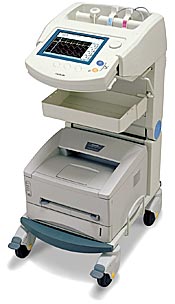Vascular Profiling system reduces PAD detection time
The American Heart Association/American College of Cardiology guidelines for managing patients with peripheral arterial disease advocate for a more proactive evaluation of patients at risk for the disease. New technology may reduce the time it takes for evaluation, while increasing the likelihood of accurate results.
The guidelines were originally chartered by the American Heart Association/American College of Cardiology and co-created by the Society for Vascular Surgery, the Society for Interventional Radiology and the Society for Cardiovascular Angiography and Interventions.
The VP-1000 (Omron) is a noninvasive device that simultaneously measures the ankle-brachial index (ABI) and pulse wave velocity, and uses waveform analysis and vascular evaluation technology to generate diagnostic information. The device’s capacity to evaluate patients highly correlates with classic Doppler measurement, according to a study on the VP-1000 by Yamashina et al, published in Hypertension Research in 2002. Omron introduced the device last year at the American College of Cardiology 55th Annual Scientific Sessions.
Measurements using the VP-1000 are performed within five to 10 minutes, a time frame that is shorter than with classic Doppler measurements, which usually require 15 to 20 minutes, according to a company spokesperson. The VP-1000 can be used in a physician’s office or a vascular laboratory and requires little training and technical skill.
Easily interpreted report
“A potential benefit of the device is that it offers within a single, small-profile machine or device the ability to perform an [ABI] easily, accurately and with an easily interpreted report,” said Alan T. Hirsch, MD, director, vascular medicine program, Minneapolis Heart Institute and chairman of the writing committee for the PAD guidelines.
|
|
The 2006 ACC/AHA PAD guidelines advocate evaluation in a targeted group of patients who have a very high PAD prevalence, regardless of their leg symptoms. Hirsch, who is also professor of epidemiology and community health at the University of Minnesota School of Public Health, said that, theoretically, the pulse wave velocity and augmentation index diagnostic features allow a physician to define earlier signs of arterial risk.
Emile Mohler, MD, director, vascular medicine and associate professor of medicine, University of Pennsylvania, uses the VP-1000 to screen patients for a clinical research study involving a sister device. Because the VP-1000 device measures BP in all four limbs simultaneously, the entire procedure is realistically finished in about five minutes, he said. It eliminates the fluctuation in BP and other variables normally found between individual measurements.
By using oscillometric technology that gathers BP measurements on all four limbs, a proprietary algorithm and a dual chamber cuff system, the VP-1000 can ensure accurate ABI results, he said. The system provides heart rate, phonocardiogram, BMI, ECG, pulse volume recording, oscillometric envelope and pulse wave velocity.
Future use
Mohler said that widespread use of this new machine in office practice would largely depend on whether insurance companies will reimburse for performance of this broad battery of vascular tests. The suggested retail price of the device is $16,000, and it is reimbursable at the same rate as traditional measurement techniques for symptomatic patients.
“It is challenging to current national health care costs that relatively inexpensive and highly predictive tests, such as the ABI, that permit timely initiation of proven preventive care strategies, are not widely reimbursed while much more expensive, and occasionally risky, CT and MR scans are fully reimbursed,” Hirsch said.
|
|
There is full international consensus within the academic vascular community that people who are at risk , as defined by the guideline, regardless of whether claudication is present, should receive ABI testing for PAD.
“In this modern, data-driven context, it is an appropriate time for payers to come back into appropriate concordance with every national health care and PAD– focused guideline for performing this simple and risk-free test,” Hirsch said.
A fundamental question is whether there is need for smaller, low-profile ABI detection devices. Eight to 12 million Americans now have PAD, and yet most do not have an established diagnosis. Nevertheless, such individuals face a high short-term risk, he said.
“I’m excited about any new device that can provide point-of-service access to the ABI test information, maximizing patient convenience while maintaining accuracy,” Hirsch said.
Mohler said that the American Diabetes Association also recommends testing patients for PAD. The TransAtlantic Inter-Society Consensus (TASC 2) guidelines are slated for publication this month in the Journal of Vascular Surgery, and will recommend PAD testing, he said. – by Lauren Riley
For more information:
- Visit the Omron Healthcare Web site at: www.omronhealthcare.com
- Visit the American College of Cardiology’s Web site for peripheral arterial disease guidelines at: www.acc.org.


